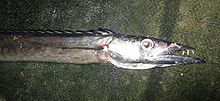Snake mackerel
| Snake mackerel | ||||||||||||
|---|---|---|---|---|---|---|---|---|---|---|---|---|

Snake mackerel ( Gempylus serpens ) |
||||||||||||
| Systematics | ||||||||||||
|
||||||||||||
| Scientific name of the genus | ||||||||||||
| Gempylus | ||||||||||||
| Cuvier , 1829 | ||||||||||||
| Scientific name of the species | ||||||||||||
| Gempylus serpens | ||||||||||||
| Cuvier, 1829 |
The snake mackerel ( Gempylus serpens ) is the eponymous species of the snake mackerel family (Gempylidae). Her snake-like body with an anguilliform , "meandering" way of swimming enables her to approach victims without being recognized as a large predatory fish. Like 12 other of the 16 species of the Gempylidae, the species is placed in a monotypical genus.
The snake mackerel became well known through a photo by Thor Heyerdahl when a specimen was washed onto his Kon Tiki raft in a large wave .
Appearance
It is a fairly dense tropical and subtropical fish that is quite common in all seas. You seldom see it because it loves the dark and does not stay close to the surface during the day, but rather sinks to dim depths (up to approx. 700 m); in the evening he rises again. Thanks to its large eyes, it is primarily optically oriented (the fish loses the cones in the retina during the transition to mesopelagic life ). Its color is a dark silver-brown, the fins are also colored like this, e.g. T. almost black. The dentition looks threatening and consists of smaller teeth and a number of large, arched fangs, especially in the upper jaw. The lower jaw is slightly extended in front. The lateral line is divided away from the posterior edge of the gill cover : the dorsal branch runs dorsally to below the D2, the ventral one straight to the bilobed caudal fin. The length hardly exceeds 1 m. The fish is 15–19 times longer than it is tall; the head measures almost 1/6 of the total length. 48–55 vertebrae.
Fins formula : D1 XXVI – XXXII, D2 I / 10–14, A II / 10–12 (spines very short) - followed by 5–6 or 5–7 fins. P 11-14. VI / 3–4, whereby the sting (still long in juvenile fish) is common to both fins; the Vs are tiny on sex tires.
Occurrence
Generally between 42 ° N and 40 ° S. (Rarely far from the coast.) Rarely on the coasts of Labrador, South England, Patagonia, South Australia, Tasmania, South New Zealand, British Columbia, but also Bangladesh to Insulin . Adults apparently like to penetrate into the colder: single catches as far as the Bering Strait, the White Sea, Greenland and Tierra del Fuego; but also in the western Mediterranean, the Aegean and the southern Red Sea. Comes to the North Sea more often as a result of climate change. It is possible that the “type” can be broken down into several, e.g. B. due to different vortex numbers.
Behavior and meaning
The otherwise “solitary” fish spawns close to the surface all year round in warmer parts of the sea; the larvae feed on plankton and therefore live epipelagic, in transparent layers. The fry switch to the “predatory” way of life and begin their hunt for smaller fish (e.g. lantern fish ), octopus and nectic crustaceans. Gempylus becomes sexually mature from about 40 (males) or 50 cm in length. The eggs are scattered in the open water. There is hardly any targeted fishing for mackerel; but caught as bycatch they are suitable for various preparations. Incidentally, the Polynesians in Hawaii regarded them as inferior. As food they are important z. B. for Istiophoridae (sailfish), tuna and dolphins.
designation
" Gempylus " seems to have been coined by Cuvier in 1829 following γαμφηλαί, "Kiefer" (Mz., I.e. upper and lower jaw) and (Latin.) Serpens = "snake", from serpere "(legless crawl)". It is possible that Bory de St. Vincent (1804) described this animal under the generic name “ Acinacea ” (Latin: “the tubular”), so that the old name Acinaceidae can still be found for the family. Hans Sloane had it listed under " serpens marinus ", and so it is not surprising that it is considered mature , especially since it has barely visible scales ( only scaly fish can be kosher ).
literature
- Izumi Nakamura, Nikolaj V. Parin: Snake mackerels and cutlassfishes of the world. An annotated and illustrated catalog of the Snake Mackerels, Snoeks, Escolars, Gemfishes, Sackfishes, Domine, Oilfish, Cutlassfishes, Scabbardfishes, Hairtails, and Frostfishes known to date (= FAO Species Catalog. Vol. 15 = FAO Fisheries Synopsis. No. 125 , Vol. 15). Food and Agriculture Organization of the United Nations, Rome 1993, ISBN 92-5-103124-X .
- John D. McEachran and Janice D. Fechhelm: Fishes of the Gulf of Mexico. Volume 2: Scorpaeniformes to Tetraodontiformes. University of Texas Press, Austin TX 2005, ISBN 0-292-70634-0 .
Web links
- Mackerel on Fishbase.org (English)
Single receipts
- ↑ Walbaum described the fish in 1792 as " Muraena compressa "!
- ↑ Shaun P. Collin, N. Justin Marshall (Eds.): Sensory Processing in Aquatic Environments. Springer, New York NY et al. 2003, ISBN 0-387-95527-5 .
